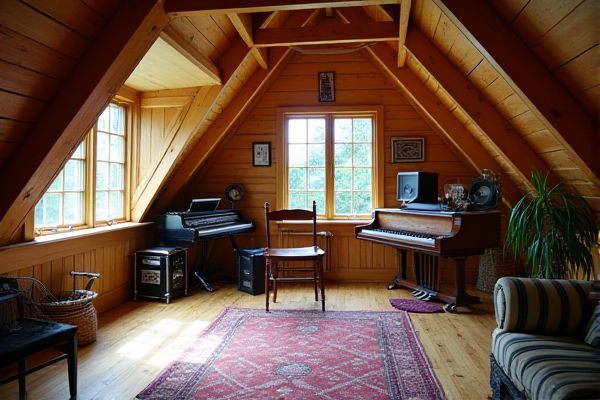
An attic art studio offers a quiet, well-lit space ideal for painting, drawing, or crafting, fostering creativity through natural light and inspiring surroundings, while an attic music studio focuses on soundproofing and acoustics to create an optimal environment for recording or practicing instruments. Discover which attic transformation suits Your creative needs best by exploring the full comparison in the article.
Table of Comparison
| Feature | Attic Art Studio | Attic Music Studio |
|---|---|---|
| Purpose | Visual arts creation (painting, drawing, sculpting) | Music production and recording |
| Acoustic Treatment | Minimal acoustic needs, natural lighting prioritized | Essential soundproofing and acoustic panels |
| Equipment | Easels, canvases, brushes, art supplies | Microphones, mixers, speakers, recording devices |
| Lighting | Bright natural and adjustable task lighting | Controlled lighting to avoid interference with audio |
| Space Layout | Open workspace for freedom of movement | Optimized for equipment placement and sound flow |
| Ventilation | Good ventilation for paint fumes | Standard ventilation, with emphasis on cooling electronics |
| Flooring | Durable, easy-to-clean surfaces | Carpet or sound-absorbing flooring |
| Power Needs | Standard electrical outlets for tools and lighting | High power demand for audio equipment and computers |
| Noise Considerations | Low concern, external noise less impactful | High concern, sound isolation critical |
Introduction to Attic Creative Spaces
Attic art studios provide a bright, inspiring environment perfect for painting, drawing, and visual creativity with ample natural light and wall space for displays. Attic music studios are soundproofed, acoustically treated areas designed specifically for recording, mixing, and producing music with professional equipment. Your choice between an attic art studio and an attic music studio depends on whether your creative focus is visual arts or audio production needs.
Key Differences: Art Studio vs Music Studio
An attic art studio primarily focuses on visual creativity, equipped with easels, canvases, paints, and natural lighting to enhance artistic work, while an attic music studio emphasizes sound design, featuring soundproofing, instruments, microphones, and audio equipment for recording and mixing. The spatial setup in an art studio prioritizes open areas for movement and material storage, contrasting with the organized, acoustically treated layout of a music studio to optimize sound quality. Both studios adapt attic spaces uniquely, but their core functions--visual expression versus audio production--define distinct environmental and equipment requirements.
Essential Equipment for Each Studio
An attic art studio requires essentials like easels, quality lighting, canvases, and a variety of paints and brushes to support creative visual work. In contrast, an attic music studio depends on soundproofing panels, audio interfaces, microphones, headphones, and digital audio workstations (DAWs) for recording and music production. Both studios benefit from ergonomic furniture and storage solutions tailored to their specific equipment needs.
Lighting Needs: Visual Art vs Sound Production
Attic art studios require ample natural and adjustable lighting to accurately perceive colors and fine details, often utilizing daylight bulbs and large windows to enhance visibility. Attic music studios demand controlled lighting that minimizes glare and external distractions, often favoring dimmable, indirect lighting to maintain focus and preserve the room's acoustic integrity. Your choice between the two should prioritize optimizing light conditions that best support either visual clarity for art or sound quality for music production.
Acoustic Considerations in Attic Studios
Acoustic considerations in attic art studios prioritize controlling natural light and minimizing external noise to create a distraction-free visual workspace, often using thick curtains and soft furnishings to absorb sound. Attic music studios demand more rigorous acoustic treatment, including specialized panels, bass traps, and soundproofing materials to manage sound reflections and prevent noise leakage. Your choice depends on whether you need optimized sound clarity for recording or a quiet environment for creative visual work.
Maximizing Space for Art and Music Creation
Maximizing space in an attic art studio involves utilizing vertical storage, adjustable lighting, and multi-functional furniture to create an inspiring environment for painting and crafting. In contrast, an attic music studio prioritizes soundproofing, acoustic panels, and compact instrument storage to optimize sound quality and workflow. Your choice depends on the creative focus, but both setups benefit from efficient space management to enhance productivity.
Ventilation and Climate Control Challenges
Attic art studios often require enhanced ventilation systems to address heat buildup and adequate airflow for drying paints and preventing solvent fumes. Attic music studios face unique climate control challenges, needing both noise insulation and temperature regulation to protect sensitive electronic equipment and maintain comfortable acoustics. Your choice between the two should consider ventilation solutions that balance air quality with soundproofing and temperature stability.
Creative Workflow in Attic Studios
Attic art studios offer a visually inspiring environment with natural light and open space, enhancing your creative workflow by encouraging spontaneous sketching and painting. In contrast, attic music studios provide acoustic treatment and soundproofing to optimize audio quality, allowing musicians to focus on recording and mixing without distractions. Both spaces foster creativity uniquely; art studios emphasize visual expression while music studios prioritize auditory precision in your artistic process.
Storage Solutions for Artists vs Musicians
Attic art studios benefit from versatile storage solutions such as modular shelves, drawers for brushes and paints, and flat racks for canvases, optimizing space for creative tools and materials. Attic music studios require specialized storage including instrument racks, soundproof cabinets for equipment, and cable organizers to maintain a clutter-free environment. Your choice between these studios should hinge on efficient, tailored storage systems that support the specific demands of either visual or audio artistry.
Choosing the Right Attic Studio for Your Passion
Selecting between an attic art studio and an attic music studio depends on your primary creative outlet and the space's acoustic or lighting needs. Art studios require ample natural light and ventilation for painting or sculpting, while music studios prioritize soundproofing and acoustics to enhance recording quality. Your ideal attic studio should align with your artistic discipline, ensuring a functional environment that fuels inspiration and productivity.
 homyna.com
homyna.com